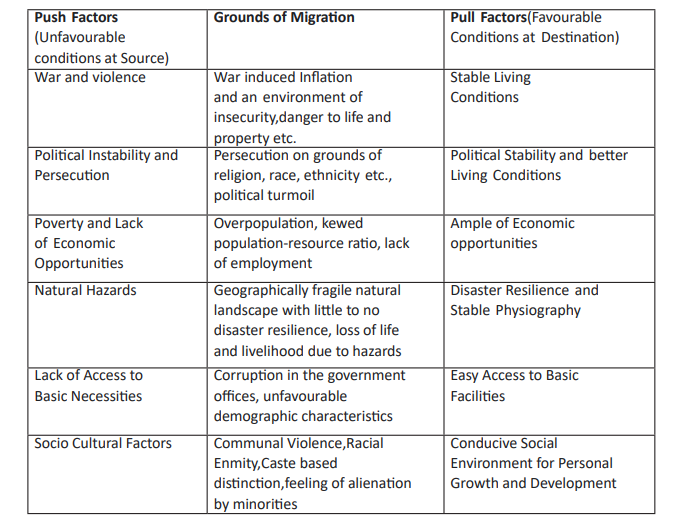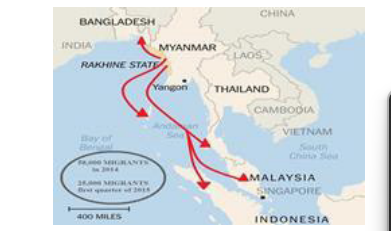
Migration is a complex phenomenon influenced by a myriad of factors, with push and pull factors standing out as crucial elements shaping the movement of populations. Push factors are those that compel individuals to leave their current place of residence, often due to adverse conditions such as economic hardships, political instability, or environmental challenges. On the other hand, pull factors act as magnets, attracting individuals to new destinations by offering opportunities, better living conditions, or political stability. The intricate interplay between these push and pull factors significantly impacts migration patterns, leading to the emergence of distinct settlement trends. Understanding how these factors influence migration is essential for comprehending the dynamics of new settlement patterns, as individuals and communities seek environments that align with their aspirations and alleviate the challenges they face in their current locations. By analyzing the push and pull forces at play, researchers and policymakers gain valuable insights into the forces shaping the distribution of populations and can formulate strategies to address the underlying causes and consequences of migration.
Contents
- 1 Answer
- 1.1 Push from war and Violence towards safe and secure regions
- 1.2 From regions of Political Instability and Persecution towards regions with freedom and stability .
- 1.3 From regions of Poverty and low Economic opportunities to regions of prosperity
- 1.4 Migration due to climate change from vulnerable regions to more stable regions
- 1.5 Their role in understanding new settlement patterns
- 2 In case you still have your doubts, contact us on 9811333901.
Answer
According to the United Nations International Organisation for Migration,the estimated number of international migrants in the world in 2020 was 281 million(3.6% of the global population). The driving force behind migration is the complex interplay of various push and pull factors,this was stressed by Lee in his theory of migration:


Push from war and Violence towards safe and secure regions
- Eg.From syria to Turkey,Lebanon,Iraq and North African countries due to Syrian Civil War(Over 13 million people have been displaced from their homes)

From regions of Political Instability and Persecution towards regions with freedom and stability .
- Eg.Rohingya refugee migrating from persecution in Myanmar towards Bangladesh and India
- Migration from Venezuela due to political instability,crime to Colombia,Perú,Ecuador,Chile and Brazil

From regions of Poverty and low Economic opportunities to regions of prosperity
- Eg.Migration of people from Mexico and Central America to the United States
- Migration of people from Africa (Nigeria, Libya, Eritrea, Sudan etc.) to Europe(France, Germany, Italy, Spain, UK etc.)
Migration due to climate change from vulnerable regions to more stable regions
- Eg.Ongoing drought in the Horn of Africa,aftermath of Hurricane Katrina, which devastated the Gulf Coast of the United States in 2005 led people to migrate
Their role in understanding new settlement patterns
- New settlement patterns can be influenced by both push and pull factors.For eg.,if a country is experiencing war or violence, people may be forced to flee to safer countries, leading to formation of new refugee settlements in receiving countries.

- If a country is experiencing economic growth,people from other countries may be attracted to the country in search of better job opportunities and higher wages,leading to formation of new immigrant colonies in receiving countries eg.Tibetan colonies: There are a number of Tibetan colonies in India, including Dharamsala.
- Migration induced due to climatic factors can also lead to formation of ghost towns and villages(Ghost villages in India are villages that have been abandoned by their inhabitants due to migration)eg.Pipra is a ghost village in the state of Bihar,abandoned by its inhabitants in the 2010s due to climate change.
- Unsustainable migration into areas of economic opportunities can lead to hyper urbanization with problems like development of slums and squatter settlement.
- For eg. Delhi’s squatter settlement like Burari and slums like Seemapuri,Seelampur etc
- Gentrification as an outcome of migration.

By understanding the push and pull factors that motivate people to migrate, we can better understand new settlement patterns and the forces that shape them. This information can be used to develop policies and programs that support migrants and the communities in which they settle.
In case you still have your doubts, contact us on 9811333901.
For UPSC Prelims Resources, Click here
For Daily Updates and Study Material:
Join our Telegram Channel – Edukemy for IAS
- 1. Learn through Videos – here
- 2. Be Exam Ready by Practicing Daily MCQs – here
- 3. Daily Newsletter – Get all your Current Affairs Covered – here
- 4. Mains Answer Writing Practice – here

